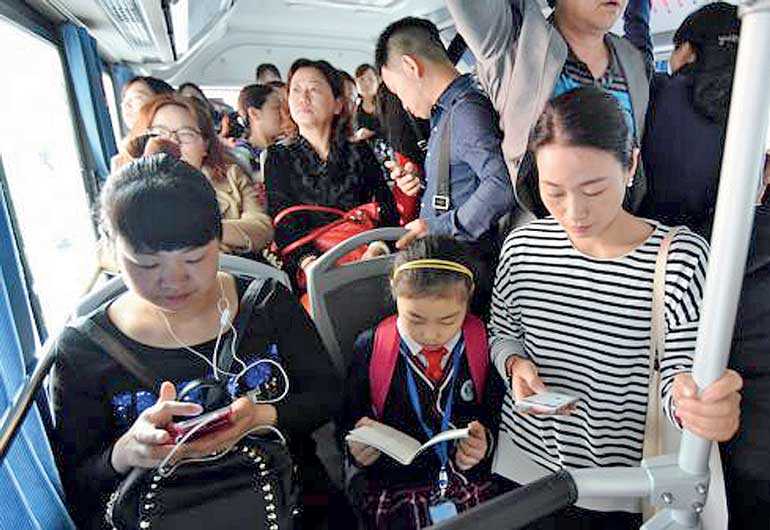Wednesday Apr 30, 2025
Wednesday Apr 30, 2025
Wednesday, 13 June 2018 09:34 - - {{hitsCtrl.values.hits}}

By Susan Lim
blogs.adb.org: An intelligent transport system (ITS) utilises vehicle and transport infrastructure data to manage and distribute information to improve transport outcomes. Developing such systems to connect multiple modes of transport and facilitate travel demand management is crucial for continued economic growth and sustainable urbanisation.
Some ITS technologies are already well integrated into modern life. For instance, many of us rely on apps to manage our travel patterns, like Waze for deciding which route to take, or Uber and Grab for ride sharing.
Other apps highlight the fastest bicycle routes or tell us which train lines are in service. They help us determine which transport mode to use at what time, and how long a journey will take.
ITS tools improve efficiency and productivity. We make more informed decisions about when and how to travel, which in turn mitigates traffic congestion. Having a robust, comprehensive ITS framework boosts economic growth by enabling citizens and governments to better manage their resources.
Asian cities are increasingly turning to ITS solutions to control traffic and direct passengers to more efficient public transport modes.
Singapore’s congestion pricing scheme employs a user pay system to differentiate driving costs in the city at various hours of the day. The contactless smart card system in Hong Kong, China makes taking public transportation much more convenient, and has pioneered a ubiquitous method of cashless spending in the city. Finally, Seoul’s bus information system provides passengers with real-time arrivals and departures, increasing both user satisfaction and ridership.
The recently unveiled Xiong’an New Area Masterplan in the People’s Republic of China (PRC) hopes to push ITS penetration even further by controlling traffic through a targeted 80% mode share of public transport in 20 years, but also capitalising on ITS technology to help create modern, green and livable cities.
Like Xiong’an, Gui’an New District in Guizhou Province aims to use ITS to curb traffic congestion and related negative impacts before they start. Anticipated to become a key economic hub in the western PRC, Gui’an is targeting 60% public transport and 80% green transport mode shares to meet a planned population increase of over 120% by 2030.
ADB can help countries incorporate ITS into their transport projects to help manage traffic growth and mitigate congestion. We are helping Gui’an with its ambitious forward planning to develop innovative ITS solutions for comprehensive travel management.
Although not all countries can take such ambitious approaches to developing their own ITS, with suitable preparation many will find that some level of ITS implementation is well within reach. To achieve this goal, countries should specifically include ITS creation in their national development plans and transport master plans.
Once national ITS architecture and standards are devised to optimise data integration and communication, specific ITS projects can be designed, and investment will follow.
Coming up with ITS funding may initially seem daunting, but these projects in fact cost less than transport capital projects, are rarely standalone, and generate return on investment.
For example, when developing a bus rapid transit (BRT) system, a bus information system (BIS) is included as part of the project. The cost of the BIS is a fraction of the cost of constructing the BRT lanes and purchasing buses. But the BIS will help improve the user environment and fare collection, which in turn encourages the use and sustainability of the BRT system.
Incorporating ITS approaches into transport projects is therefore a good way for countries to improve return on their infrastructure investment, as well as generate savings through increased transport efficiency.
The next wave of ITS technologies is fast approaching, whether it be in the form of using Big Data to comprehend travel patterns and provide real-time traffic management and control, running shared bicycle and vehicle programs to cut the number of automobiles on the roads, or employing autonomous vehicles to improve mobility and road safety.
Whatever the form, adopting these technologies and incorporating them into the urban fabric is crucial to develop sustainable urban transport systems in Asia and the Pacific.
(The writer is Senior Transport Specialist, East Asia Department, Asian Development Bank.)
Discover Kapruka, the leading online shopping platform in Sri Lanka, where you can conveniently send Gifts and Flowers to your loved ones for any event including Valentine ’s Day. Explore a wide range of popular Shopping Categories on Kapruka, including Toys, Groceries, Electronics, Birthday Cakes, Fruits, Chocolates, Flower Bouquets, Clothing, Watches, Lingerie, Gift Sets and Jewellery. Also if you’re interested in selling with Kapruka, Partner Central by Kapruka is the best solution to start with. Moreover, through Kapruka Global Shop, you can also enjoy the convenience of purchasing products from renowned platforms like Amazon and eBay and have them delivered to Sri Lanka.
Discover Kapruka, the leading online shopping platform in Sri Lanka, where you can conveniently send Gifts and Flowers to your loved ones for any event including Valentine ’s Day. Explore a wide range of popular Shopping Categories on Kapruka, including Toys, Groceries, Electronics, Birthday Cakes, Fruits, Chocolates, Flower Bouquets, Clothing, Watches, Lingerie, Gift Sets and Jewellery. Also if you’re interested in selling with Kapruka, Partner Central by Kapruka is the best solution to start with. Moreover, through Kapruka Global Shop, you can also enjoy the convenience of purchasing products from renowned platforms like Amazon and eBay and have them delivered to Sri Lanka.